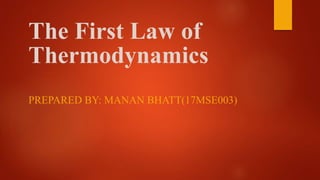The first law of thermodynamics
•Als PPTX, PDF herunterladen•
15 gefällt mir•18,288 views
The document summarizes the first law of thermodynamics. It states that energy cannot be created or destroyed, only changed from one form to another. The total amount of energy in the universe remains constant. Energy exists in many forms, including mechanical, heat, light, chemical and electrical. Thermodynamics is the study of energy and how it is transferred or changed from one system to another or between systems and their surroundings.
Melden
Teilen
Melden
Teilen

Weitere ähnliche Inhalte
Was ist angesagt?
Was ist angesagt? (20)
Ähnlich wie The first law of thermodynamics
Ähnlich wie The first law of thermodynamics (20)
Thermodynamics ,types of system,formulae ,gibbs free energy .pptx

Thermodynamics ,types of system,formulae ,gibbs free energy .pptx
Bioenergetics and the role of ATP to drive the beats of life.

Bioenergetics and the role of ATP to drive the beats of life.
Some basic terms in thermodynamics ( introductory terms) (other ppt can also ...

Some basic terms in thermodynamics ( introductory terms) (other ppt can also ...
Mehr von paneliya sagar
Mehr von paneliya sagar (20)
Kürzlich hochgeladen
Model Call Girl in Tilak Nagar Delhi reach out to us at 🔝9953056974🔝

Model Call Girl in Tilak Nagar Delhi reach out to us at 🔝9953056974🔝9953056974 Low Rate Call Girls In Saket, Delhi NCR
YOUVE GOT EMAIL_FINALS_EL_DORADO_2024.pptx

YOUVE GOT EMAIL_FINALS_EL_DORADO_2024.pptxConquiztadors- the Quiz Society of Sri Venkateswara College
Kürzlich hochgeladen (20)
Barangay Council for the Protection of Children (BCPC) Orientation.pptx

Barangay Council for the Protection of Children (BCPC) Orientation.pptx
Choosing the Right CBSE School A Comprehensive Guide for Parents

Choosing the Right CBSE School A Comprehensive Guide for Parents
Virtual-Orientation-on-the-Administration-of-NATG12-NATG6-and-ELLNA.pdf

Virtual-Orientation-on-the-Administration-of-NATG12-NATG6-and-ELLNA.pdf
Model Call Girl in Tilak Nagar Delhi reach out to us at 🔝9953056974🔝

Model Call Girl in Tilak Nagar Delhi reach out to us at 🔝9953056974🔝
Difference Between Search & Browse Methods in Odoo 17

Difference Between Search & Browse Methods in Odoo 17
Student Profile Sample - We help schools to connect the data they have, with ...

Student Profile Sample - We help schools to connect the data they have, with ...
Procuring digital preservation CAN be quick and painless with our new dynamic...

Procuring digital preservation CAN be quick and painless with our new dynamic...
How to do quick user assign in kanban in Odoo 17 ERP

How to do quick user assign in kanban in Odoo 17 ERP
4.18.24 Movement Legacies, Reflection, and Review.pptx

4.18.24 Movement Legacies, Reflection, and Review.pptx
AMERICAN LANGUAGE HUB_Level2_Student'sBook_Answerkey.pdf

AMERICAN LANGUAGE HUB_Level2_Student'sBook_Answerkey.pdf
Like-prefer-love -hate+verb+ing & silent letters & citizenship text.pdf

Like-prefer-love -hate+verb+ing & silent letters & citizenship text.pdf
The first law of thermodynamics
- 1. The First Law of Thermodynamics PREPARED BY: MANAN BHATT(17MSE003)
- 2. The First Law of Thermodynamics FIRST LAW OF THERMODYNAMICS → CONSERVATION OF ENERGY: Energy Can Be Changed From One Form To Another, But It Cannot Be Created Or Destroyed. The Total Amount Of Energy And Matter In The Universe Remains Constant, Merely Changing From One Form To Another. Energy Exists In Many Forms, Such As Mechanical Energy, Heat, Light, Chemical Energy, And Electrical Energy. Energy Is The Ability To Bring About Change Or To Do Work. Thermodynamics Is The Study Of Energy.
- 3. Surroundings The Boundary Of The System Is Arbitrarily Chosen The System Can Exchange Mass And Energy Through The Boundary With The Environment. An Example Of “Closed System” - No Mass Flow- Is The Gas Confined In A Cylinder. The Boundary –In This Case Real Wall- Is Made By The Cylinder And The Piston Walls. System
- 4. An Isothermal Process Is One Where The Temperature Does Not Change.
- 5. In Order For An Isothermal Process To Take Place, We Assume The System Is In Contact With A Heat Reservoir. In General, We Assume That The System Remains In Equilibrium Throughout All Processes. An Adiabatic Process Is One Where There Is No Heat Flow Into Or Out Of The System.
- 6. An Isobaric Process Occurs At Constant Pressure; An Isovolumetric One At Constant Volume. If The Pressure Is Constant, The Work Done Is The Pressure Multiplied By The Change In Volume:
- 7. For Processes Where The Pressure Varies, The Work Done Is The Area Under The P-V Curve.
- 8. If We Apply The First Law Of Thermodynamics To The Human Body: We Know That The Body Can Do Work. If The Internal Energy Is Not To Drop, There Must Be Energy Coming In. It Isn’t In The Form Of Heat; The Body Loses Heat Rather Than Absorbing It. Rather, It Is The Chemical Potential Energy Stored In Foods.
- 9. The Metabolic Rate Is The Rate At Which Internal Energy Is Transformed In The Body. For 65kg person
- 10. THANK YOU